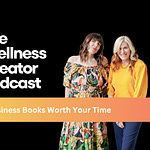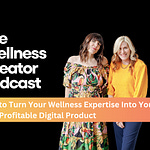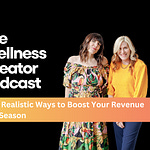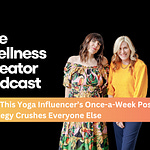"I want to start a wellness Substack, but I also want to write about being a first-time mom. Should I create two separate Substacks or keep everything together?" Sound familiar? If you're a multi-passionate creator wrestling with this exact dilemma, you're definitely not alone. We've been asked variations of this question throughout the years, and there's a reason it keeps coming up. The answer isn't as straightforward as you might hope, and most creators are approaching it from completely the wrong angle.
The Multi-Passionate Creator Reality
Let's start with some truth-telling: if you're an entrepreneur, you're probably wired differently than most people. You see opportunity everywhere. You get excited about new projects weekly (maybe daily). We completely understand the urge to start five different YouTube channels, three Substacks, and maybe throw a podcast into the mix while you're at it.
We've been there. In our years of running businesses together, we've had literally thousands of ideas that made us want to start something new. The discipline to say "no, that doesn't fit our current focus" is what actually makes our podcast successful. Otherwise, it would just be a confusing mess for our listeners.
This creative enthusiasm is both a gift and a challenge. The same energy that makes you want to start a business in the first place also makes you want to chase every shiny new opportunity that crosses your path.
The Core Question You Need to Ask
Before you make any decisions about separate channels or blended content, you need to get crystal clear on one thing: what's your actual goal here?
Are you looking to build a profitable creator business? Or are you seeking a creative outlet where you can explore different interests without worrying about monetization?
This distinction matters more than you might think. If you grew up in the early days of the blogosphere (like we did), you remember when having a personal brand meant talking about everything. Pregnancy updates, crafting projects, marathon training, career thoughts, random musings about life. That was totally normal, and it worked as a business model because blogs made money through ad revenue.
Those days are largely over. We're now in an era where creator businesses require focus to succeed financially. You can still have a personal blog or social media presence where you talk about whatever's on your mind, but if you want to make strategic money as a creator, you need to think differently.
The Clarity Equals Revenue Principle
Here's what we've learned from over a decade in this space: if you want a profitable business, you have to be clear to your audience. That clarity directly translates to revenue.
When someone follows your content, they need to understand what they're getting. If you're jumping between wellness tips, first-time mom advice, travel vlogs, and recipe testing, your audience might find you interesting as a person, but they won't know what to expect from you professionally.
More importantly, when you eventually create a digital product or course to sell, you won't have enough people interested in that specific topic to make meaningful money. The people following you for travel content probably won't buy your meal planning course. The wellness crowd might not be interested in your parenting guide.
You end up with a confused audience and scattered revenue potential.
The Hidden Cost Nobody Talks About
Let's talk about something most creators don't consider when they're excitedly planning separate channels: the actual workload.
Running two Substacks (or podcasts, YouTube channels) means creating content for both, promoting both, engaging with comments on both, and maintaining the marketing efforts for both. You've literally doubled your content creation and promotion responsibilities.
Give it six months, and you'll be overwhelmed. We've seen this pattern repeat countless times with creators we've worked with over the years.
And here's the thing: this advice is especially crucial when you're starting out. You might have more flexibility once you're established and have a loyal audience who knows you for one specific thing. At that point, they might be interested in following along with your other interests too.
But even then, you need to be strategic. We've watched established creators lose significant portions of their audience when they started sharing content that was controversial or dramatically different from what they were known for.
When Blending Actually Works
Now, before you think we're completely against multi-passionate content, let us share when combining interests can actually work beautifully.
The key is finding overlap or creating a specific niche that serves a particular audience. Take the example from our listener who wanted to write about both wellness and first-time motherhood. These topics actually complement each other perfectly.
Instead of creating generic wellness content (which honestly, nobody's searching for), you create wellness content specifically for first-time mothers. Suddenly you have a very specific audience who will see themselves in your content and messaging.
This isn't about having two separate topics. It's about taking your expertise and interests and finding where they intersect to serve a specific group of people better than anyone else could.
AI tools can beat any of us at creating general content now. Your real value lies in specificity and going deep into niche combinations that serve small but passionate audiences.
The Decision Framework
So how do you actually decide what to do? We've developed a simple decision filter that cuts through the overthinking:
If your goal is to make money: Niche down. Pick one focused topic or one specific intersection of topics. This is non-negotiable if profit is your priority.
If you want a personal creative outlet and money isn't the focus: You have more freedom to experiment and explore different topics. Just understand that monetization will be much more challenging later.
If you really want to express multiple sides of yourself: Consider separate channels or accounts, but seriously think about whether you can sustain the workload long-term.
If you're just excited about learning something new: Maybe create a contained project. Decide you're going to document learning woodworking for six months on YouTube, with a clear end date. This gives you a playground without the ongoing commitment.
The Collaborative Approach
Here's something most creators don't think to do: ask your existing audience what they want more of.
If you've already been creating content and have even a small following, you can post surveys or polls to get feedback on what direction to take your work. This collaborative approach takes the pressure off you to have all the answers and often reveals that what your audience wants is simpler than you think.
We've seen this repeatedly in our coaching programs. Creators tie themselves in knots overthinking their offerings, then discover their audience just wants more time with them or simple answers to their questions.
The Money Reality Check
We need to address something directly: you don't need to monetize everything you care about.
If you're passionate about something and want to build a community around it, that's wonderful. You can spend years creating content around a hobby or interest without ever turning it into a business.
But if you need to make money right now, be strategic with your time and energy. Starting a new creative business is like raising a newborn. You might need to put other interests on the back burner while you get one thing off the ground and profitable.
The economy has been challenging lately, and many creators are feeling financial pressure. If that's you, focus on finding something your audience needs and build content around that specific need. Then monetize that focused content.
Permission to Start Imperfectly
Here's the final piece we want to leave you with: you don't need to have this perfectly figured out before you start.
Choose one direction, launch something, and see how it lands. Give yourself permission to make adjustments along the way. You can pivot, refine, or even start over if needed.
The perfectionist mindset that says "this is what I've decided and I must stick to it forever" will keep you stuck in planning mode indefinitely. Instead, think of your first launch as an experiment that will give you data to make better decisions moving forward.
The Bottom Line
Multi-passionate creators face a real dilemma, but the solution doesn't have to be complicated. Start with clarity about your goals, choose one focused direction, and build from there. You can always expand later once you've established yourself in one area.
The creators who make sustainable money are the ones who resist the urge to do everything at once and instead go deep in one specific area first.
Trust the process. Pick your lane, build your audience, establish your expertise, and then you'll have the platform and credibility to explore other interests if you choose to.












